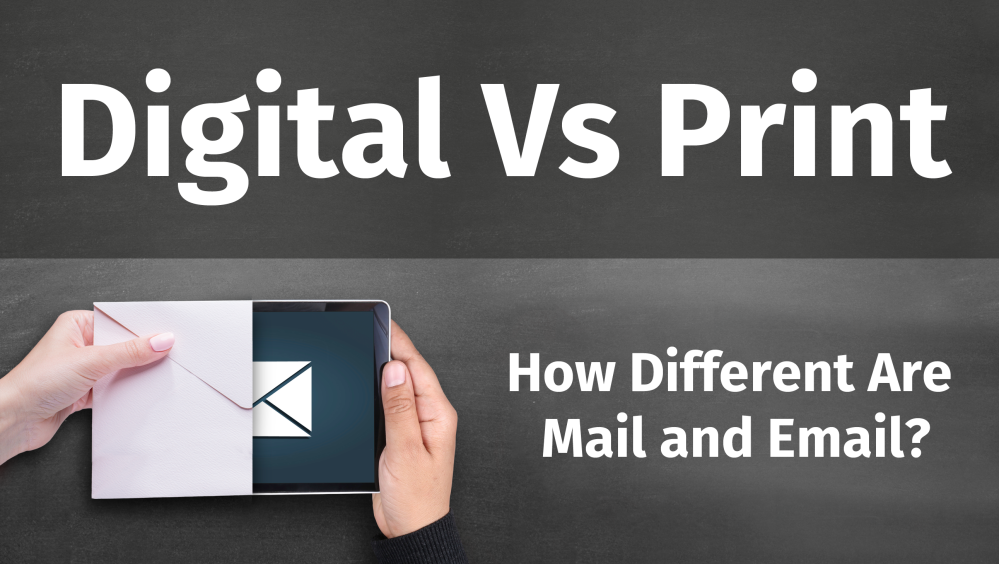Digital Vs Print: How Different Are Mail and Email?
14 Oct 2016

In a time where digital communications are rapidly increasing, we decided to look in to how email really compares to mail. Have you ever wondered how many more emails than letters we send? What about how much value each medium holds, or how many people take action as a result of a mail or email communication? We aim to answer those questions, and more!

Read more below:

Mail: The average letter volumes sent/received per year in UK are currently around 13 billion.
Email: The average number of emails sent PER DAY are currently around 215.3 billion.
- So many emails are sent and received per day, it would take the UK 16.5 years to send as many letters!
The difference here is vast. Emails are cheaper, faster and more convenient and as a result we are bombarded with them. In terms of volume, it’s hard to make a comparison that makes sense.

Mail: The average time advertising mail is kept in the home is 17 days.
Email: 50% of emails are opened within the first 24 hours, ands 80% were opened within 12 days of being sent.
- Once opened, emails can easily be forgotten. A piece of mail around the home is a constant reminder.
As we’re all aware, email communication is very immediate. Direct mail can last a little longer. If you’re looking for a quick boost, email can be a good option. If you’re after a longer term strategy then direct mail could be the answer.

Mail: 92% of respondents engaged with the brand after receiving a piece of direct mail that they liked.
Email: 81% of online shoppers who receive emails based on previous shopping habits were at least somewhat likely to make a purchase as a result of targeted email.
- Both methods of communication can be highly effective if specifically targeted.
Email and direct mail are alike in that the key to success is personalization. If you get the message right, high percentages of your targets can take action as a result.

Mail: 50% of companies report using direct mail in their marketing mix.
Email: Email marketing technology is used by 82% of B2B and B2C companies.
- Email is more widely used, perhaps due to the lower startup costs.
These days it’s hard to find a company still in business who hasn’t considered email as a marketing channel. Although email is a more recent marketing tool, low starting costs and high return rates make it a firm favourite of many marketers. Although it’s a tried, tested and proven marketing method, some businesses have cut back on direct mail whilst trimming their marketing budgets.

Mail: On average, marketers spend 9% of their budget on direct mail.
Email: On average, marketers spend 10% of their budget on email.
- Although direct mail costs are higher, marketers spend a similar percentage of their budget on direct mail and email.
It’s somewhat surprising that statistics show a similar percentage of the marketing budget is allocated to direct mail as it is to email. This indicates that marketers must do less direct mail than email, as costs are higher.

Letter: Direct mail is effective for customer acquisition, costing £39.59 ($51.40) per order or lead.
Mail: Email is slightly more expensive, costing £42.55 ($55.24) per order or lead.
- Cost per acquisition between the two different channels is actually surprisingly similar!
Another interesting comparison is cost per acquisition. As the costs are similar, this suggests that more email activity is required to acquire a new lead or customer.

Mail: The average direct mail ROI is £4 for each £1 spent ($7 for each $1 spent).
Email: The average email ROI is £23 for each £1 spent ($38 for every $1 spent).
- Due to higher campaign costs, direct mail ROI is lower.
It’s probably the ROI figures that so often drive marketing professionals to choose email over direct mail. If your marketing budget only stretches so far, you’re going to want to get the most bang for your buck!

Studies have proven:
- Printed words are more cognitively engaging than electronic ones
- People believe letters are more honest than emails
- We judge email writers more negatively than letter writers
Psychological studies show that mail still has an important place in today’s digital world. Our brains process printed words differently to electronic ones, making the act of reading print more cognitively engaging. Our beliefs and judgements also change when we assess digital against print. This is well worth keeping in mind next time you choose a method of communication, whether for a personal message or a marketing campaign.
Although we often see digital and print communication methods as similar, the statistics show that they are in fact very different mediums that have their own specific functions within the marketing mix. Combining the two is the best way to reap the benefits each channel has to offer!

Please login to comment.
Comments